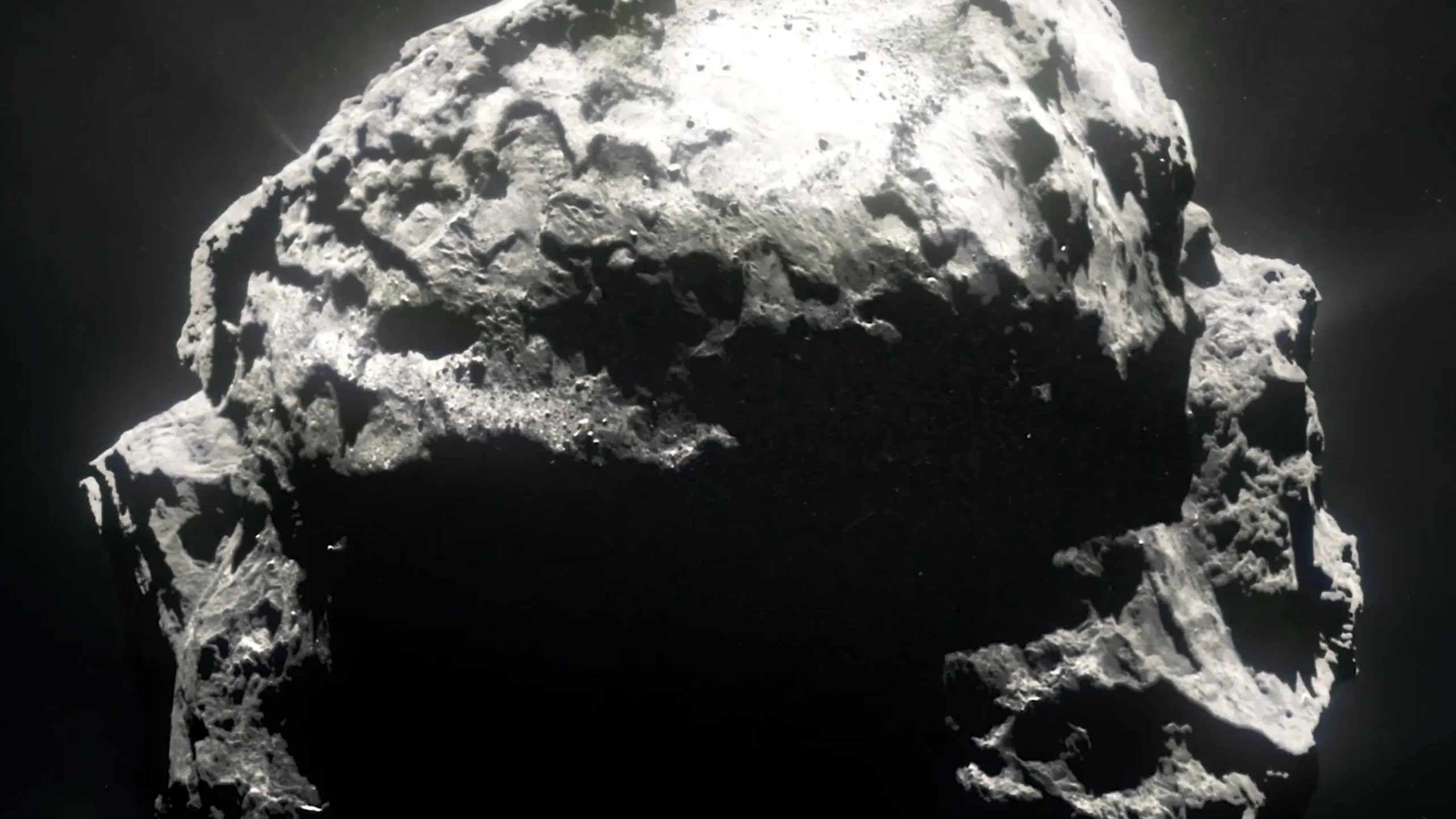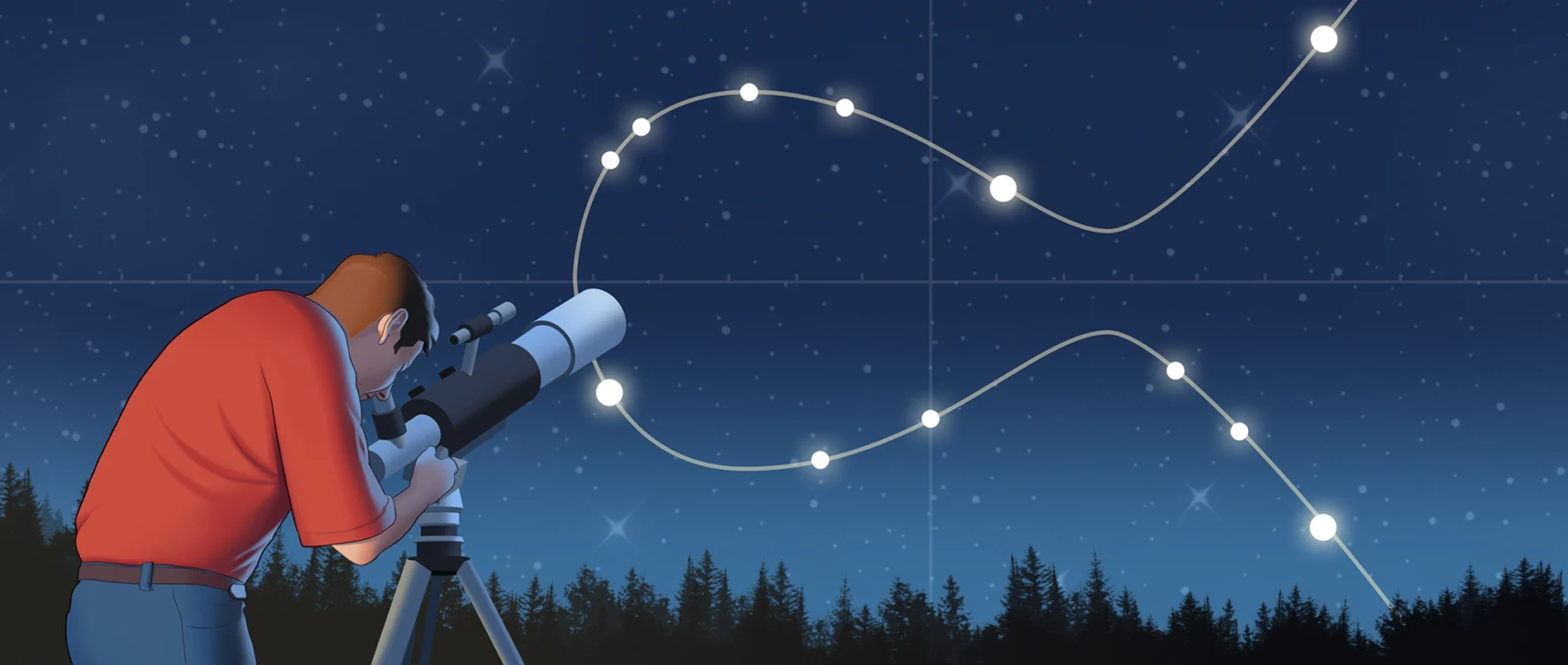The Cosmos Teems with Complex Organic Molecules
Introduction
Ten years ago, the European Space Agency’s Rosetta probe pulled up alongside a dusty, icy lump the size of a mountain. The probe would follow its quarry, a comet called 67P/Churyumov-Gerasimenko, for two years as onboard instruments caught and analyzed the dust and gas streaming away from the comet. Scientists sought hints about how our solar system came to be — and about the origin of one class of molecules in particular.
Organic molecules — compounds containing carbon — abound on Earth, especially in the bodies of living things. They’re often called the building blocks of life, and for good reason: Carbon atoms can chemically bond to four other atoms and easily form long, stable chains that serve as “carbon backbones” for complex biological molecules.
The Rosetta mission and others have shown just how ubiquitous organic molecules are in space, too.
“Rosetta really changed the view,” said Nora Hänni, a chemist at the University of Bern who has been analyzing data from the probe. When Hänni and her colleagues processed just one day’s worth of the probe’s data in 2022, they uncovered 44 different organic molecules. Some were very complex, containing 20 atoms or more. Rosetta caught whiffs of glycine, one of the amino acid building blocks of proteins. And more recently, Hänni used Rosetta data to identify dimethyl sulfide — a gas that, on Earth, is only known to be produced by living organisms.
What Rosetta did for comets, Japan’s Hayabusa2 and NASA’s Osiris-Rex are doing for asteroids. In 2020 and 2023, respectively, the two missions scooped up samples of the asteroids Bennu and Ryugu and returned the samples to Earth. Scientists have been sifting through the material ever since, and they find that both asteroids sport plenty of organic molecules. Ryugu alone contains at least 20,000 kinds, including 15 different amino acids.
“It’s just everything possible from which life could emerge,” said Philippe Schmitt-Kopplin, an organic geoscientist at the Technical University of Munich.
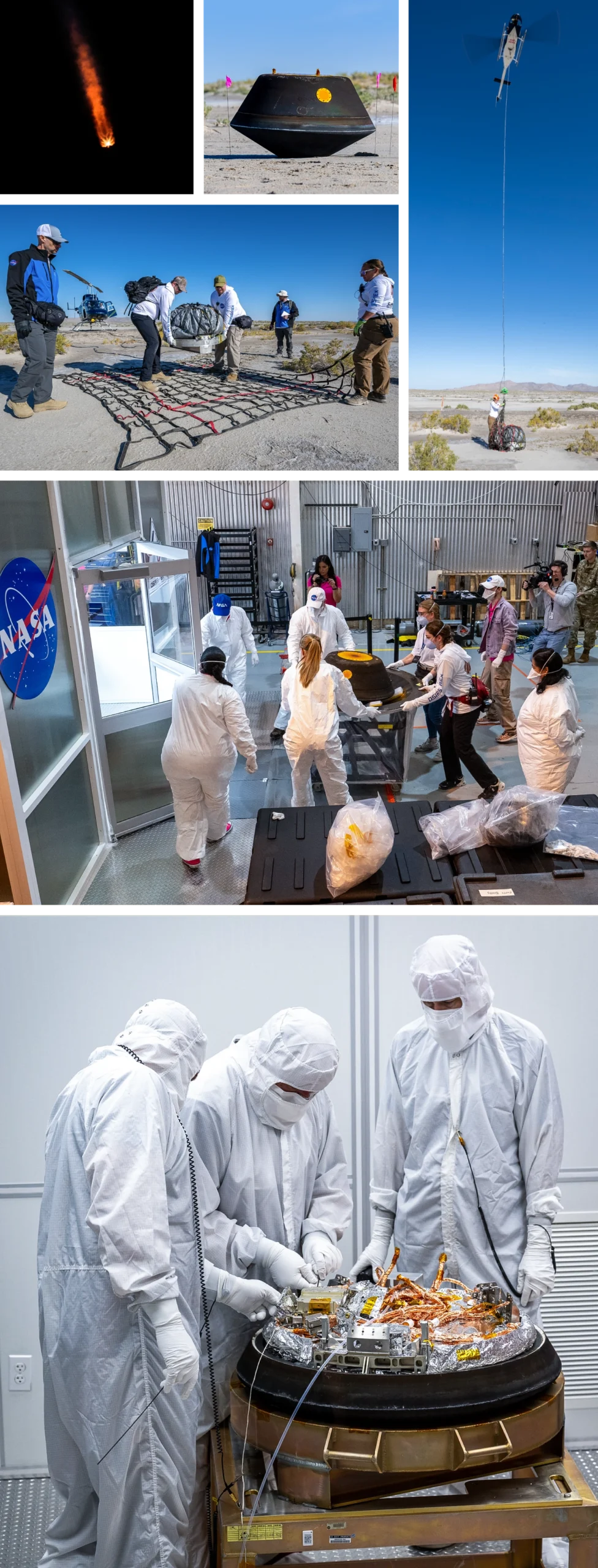

NASA
After NASA’s Osiris-Rex spacecraft scooped material from the asteroid Bennu, the capsule containing the sample reentered Earth’s atmosphere and landed in Utah in September 2023. The sample was then taken to Johnson Space Center in Houston for analysis.
NASA
How simple chemistry led to complex living organisms stands among the great unsolved mysteries of science. The recent studies of asteroid and comet material add to the evidence that the first steps of the assembly process happen in space — and happen very readily. Everywhere we look, space seems to teem with biology’s raw materials. Saturn’s moon Titan has lakes of liquid methane and ethane that are made of organic molecules, as are its hydrocarbon sand dunes. Organic molecules called tholins are probably responsible for Pluto’s reddish blush. Veritable zoos of extraterrestrial organics are found in meteorites. Organic dust drifts between the stars and rains down on Saturn from its rings.
Scientists have long wondered where these molecules come from. Did the compounds that slosh about in Titan’s hydrocarbon lakes form there, or were they around long before the icy moon even existed? How does organic complexity develop without biological evolution?
“Those of us interested in searching for life have to understand how planets could acquire organics in the absence of life,” said Christopher Glein, a planetary scientist at the Southwest Research Institute. “We spend a lot of time thinking about this.”
“I would like to know where we come from as a planetary species,” said Karin Öberg, an astrochemist at Harvard University. “This is as close as you get to one of the big origin questions, which is where Earth as a habitable planet came from. Why is it the way it is?”
By sending probes to sample primordial comets and asteroids, peering into planet-forming disks with telescopes, and re-creating spacelike conditions in labs and computer models, scientists are uncovering the origins of complex organic molecules. Their findings indicate that planets like ours likely inherit much of their organic material from a time before the sun.
Fire and Ice
Last year, researchers glimpsed the earliest known occurrence of organic chemistry in the universe. The James Webb Space Telescope observed a young galaxy, seeing it as it appeared just 1.5 billion years after the Big Bang, and detected polycyclic aromatic hydrocarbons — hefty molecules that look a bit like honeycombs. On Earth, they’re found in anything involving tar, from fossil fuels to wood smoke. In space, they’re components of asteroids — including those that fall to Earth as meteorites — and of interstellar dust.
These and other organic molecules likely formed in the twilight years of the earliest stars, perhaps as early as a few hundred million years after the Big Bang. Dying stars exhale hot stellar winds; any carbon swept up in these winds essentially burns up, producing stellar soot. “It’s actually not too different from combustion as we understand it here on Earth,” Öberg said. In the hot, gas-rich environments around dying stars, she explained, “it’s quite easy to put carbon atoms together into pretty large molecules.”
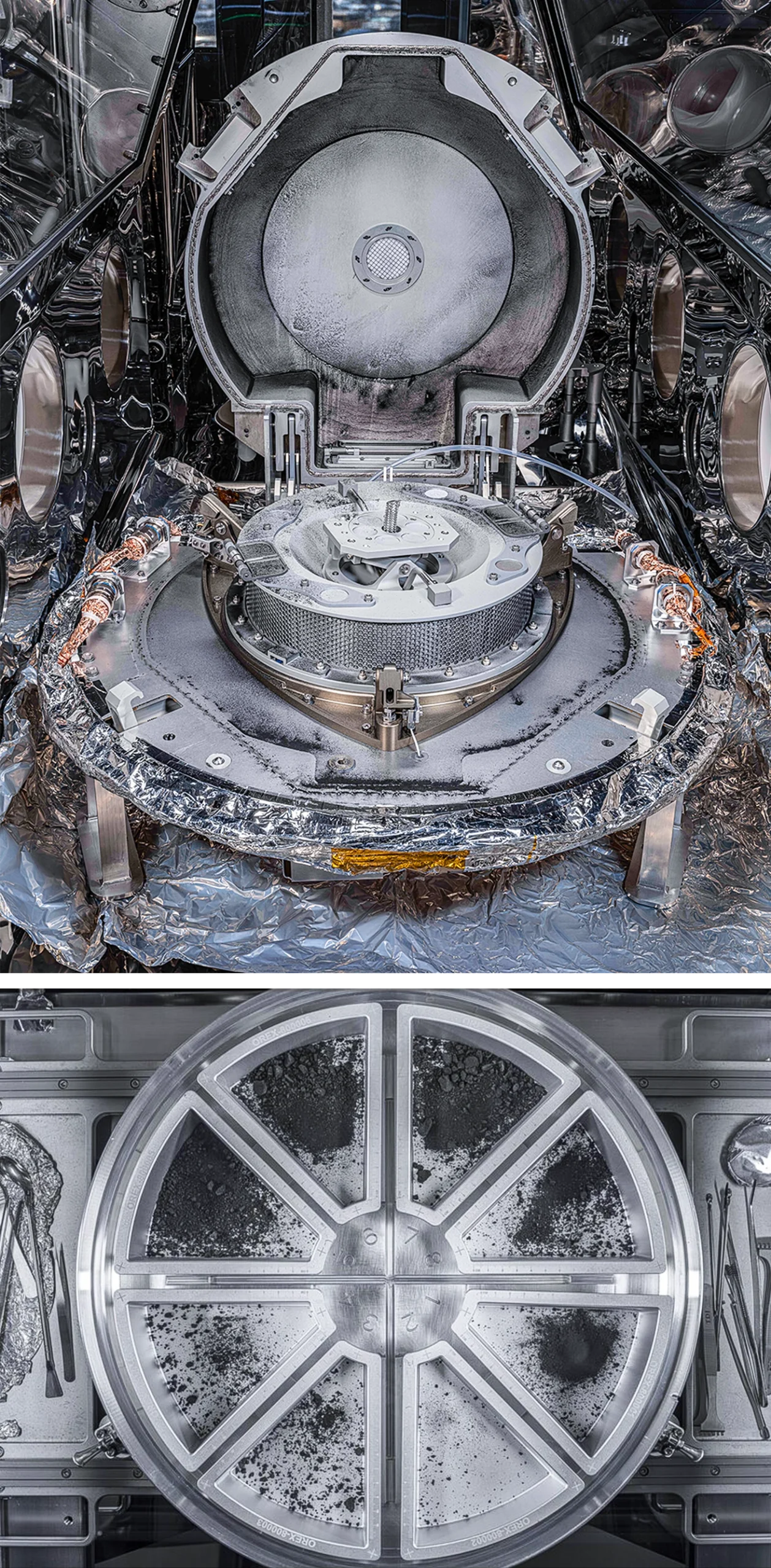
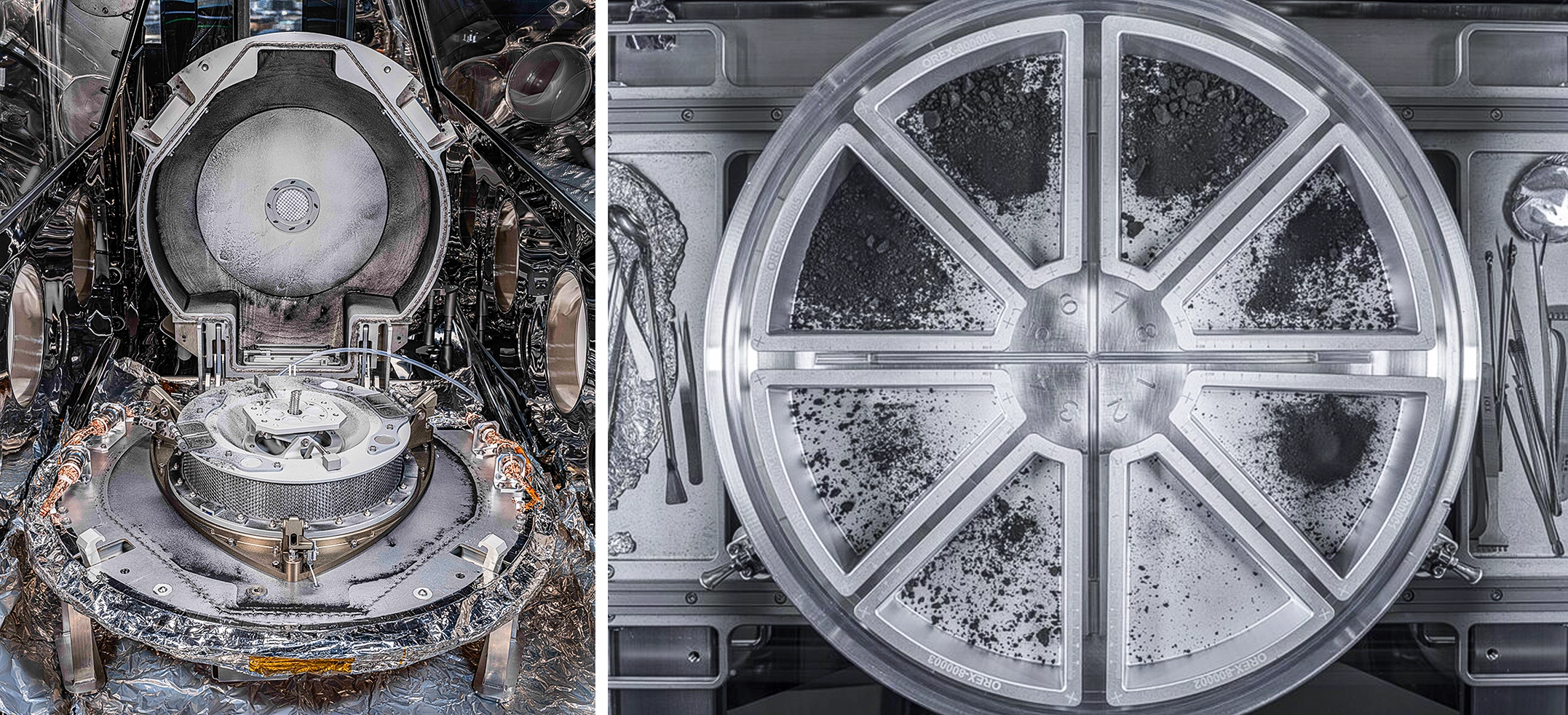
NASA
A total of 121.6 grams of sooty material from the asteroid Bennu made its way back to Earth in Osiris-Rex’s science canister (left) and the inside of the canister’s lid (right).
NASA
There’s a second major formation pathway. As generations of stars have lived, died and spilled their innards into space, some of their carbon has ended up in molecular clouds — patches of space where motes of gas and dust crowd close enough together to block out light. Here, organic molecules form within the icy crusts of tiny dust grains. “You can build complexity without much going on in just a cold, dark cloud,” said Alice Booth, an astronomer at Harvard.
Because icy grains are so cold, atoms drifting by can stick to them. Scientists experimentally confirmed in 2020 that methane, among the simplest organic molecules, forms like this, as carbon and hydrogen land on the icy grains, one after another. Methanol is thought to form in a similar way. And a 2022 study showed that it’s even possible to build up chains of the simplest amino acid, glycine, as carbon monoxide, carbon and ammonia condense on the granular surfaces.
Radiation powers these chemical reactions. Cosmic ray particles and ultraviolet light “not only can heat the ices and make reactions happen that way,” said Perry Gerakines of the Astrochemistry Lab at NASA’s Goddard Space Flight Center, “they break molecules apart and form radicals that are more reactive.” With methanol as a starting ingredient, this kind of radiation-driven chemistry can produce an enormous diversity of molecules. “Basically everything that you would find in a normal organic chemistry lab,” Öberg said. To date, scientists have detected more than 200 kinds of organic molecules in interstellar space.
The upshot, according to Booth, is that even billions of years before the sun was born, “you can form pretty complex molecules,” she said. “What we don’t really know is how all of that complexity at early times translates to later times.”
Dynamic Disks
A key question is whether these molecules can survive the birth of a solar system. New stars and planets form via the gravitational collapse of gas and dust clouds. Are the primordial organic molecules in those clouds lost in the early days of a new solar system, blasted apart as young stars blaze to life?
Only recently did scientists get their first glimpses of organic molecules within protoplanetary disks — the rotating frisbees of gas and dust that spin around newborn stars. “Every disk is a gold mine,” Öberg said. In one of these observations, Booth and her colleagues found abundant methanol within a nearby planet-forming disk. This methanol could only have formed on grains of carbon monoxide–rich ice, which would have filled the cold molecular cloud from which the protoplanetary disk came but would then have vaporized in the warm disk. So, Booth said, the methanol must have come from the cloud that predated the new star and its planets.
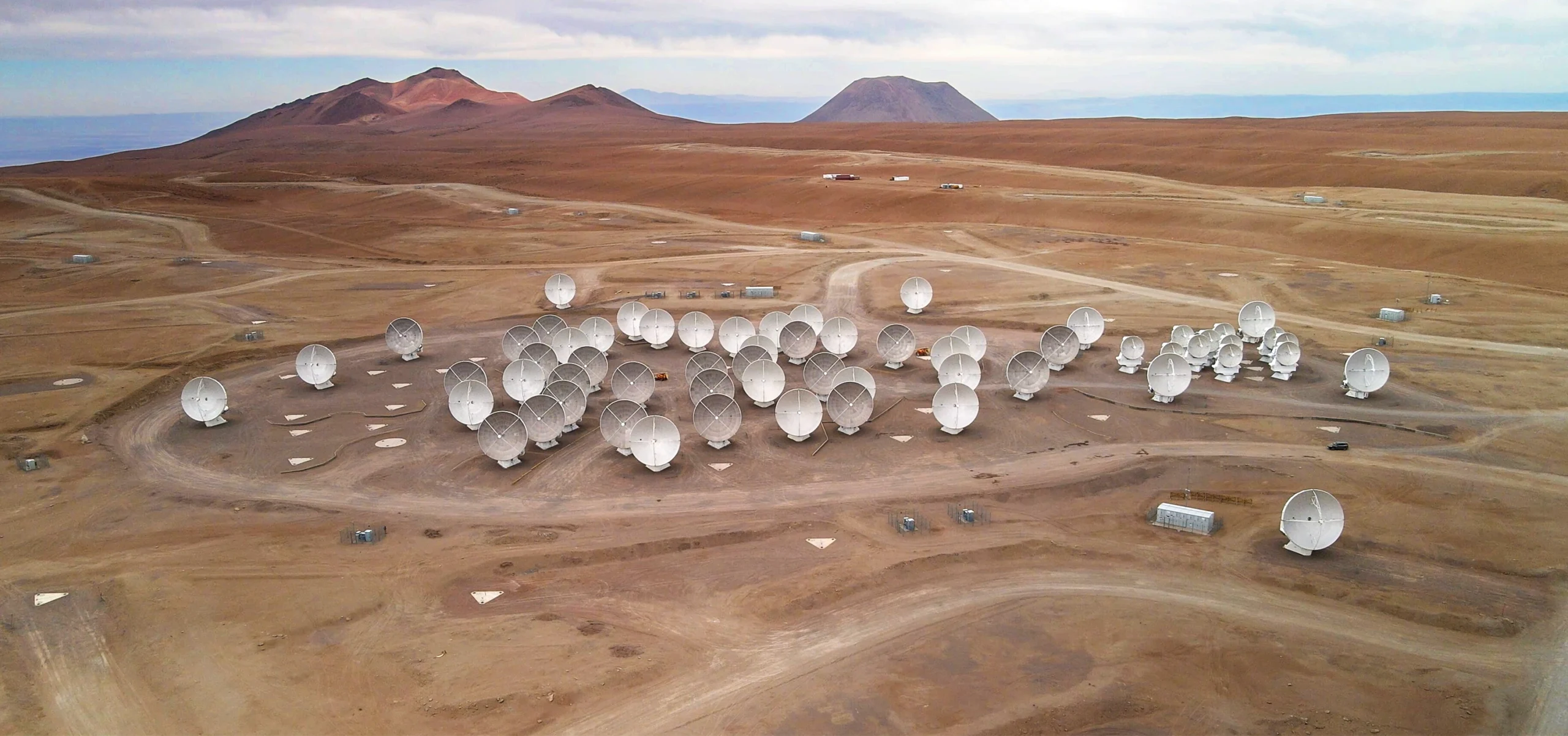
Since its 66 highly sensitive radio telescopes became operational in 2013, the Atacama Large Millimeter Array (ALMA) in Chile has picked up the glow of organic molecules infusing protoplanetary disks.
ESO Angelos Tsaousis
But the chemical assembly process probably doesn’t end in the cloud. According to Booth, “we’ve got some really interesting results that might tell us that we’re enhancing [chemical] complexity during planet formation.”
As material moves around in the disk, it experiences dramatically varying conditions. The disk’s surface is exposed to heat and radiation, while its midplane is shielded and cooler. Just as wet-dry cycles on Earth might have helped drive organic complexity at the origin of life, the flow of dust and gas through different parts of disks might drive new kinds of organic complexity.
Researchers have wanted to computationally model the churn and tumble of disk material, but it’s so computationally costly to do so that “until we absolutely had to, we have sort of been avoiding those [studies],” Öberg said. That’s changing now. In 2024 a team of scientists including Booth published initial results of computer models showing that complex organics can form rapidly in protoplanetary disks. In particular, the molecules assemble in the same “dust traps” where planetesimals, the asteroid-size building blocks of planets, coalesce. The results provide a tantalizing link between the formation of organics and planets.
In our own solar system, comets are among the most primordial material — leftovers from the protoplanetary disk. “Comets are, I think, the best that we can do to go back in time toward what happens in the interstellar medium,” Hänni said. The inventory of small organic molecules that Rosetta detected so far in comet 67P mostly lines up with what scientists would expect of material inherited from molecular clouds in interstellar space. But some organic molecules from 67P are more complex than scientists expected, and it’s still an open question where that complexity came from.
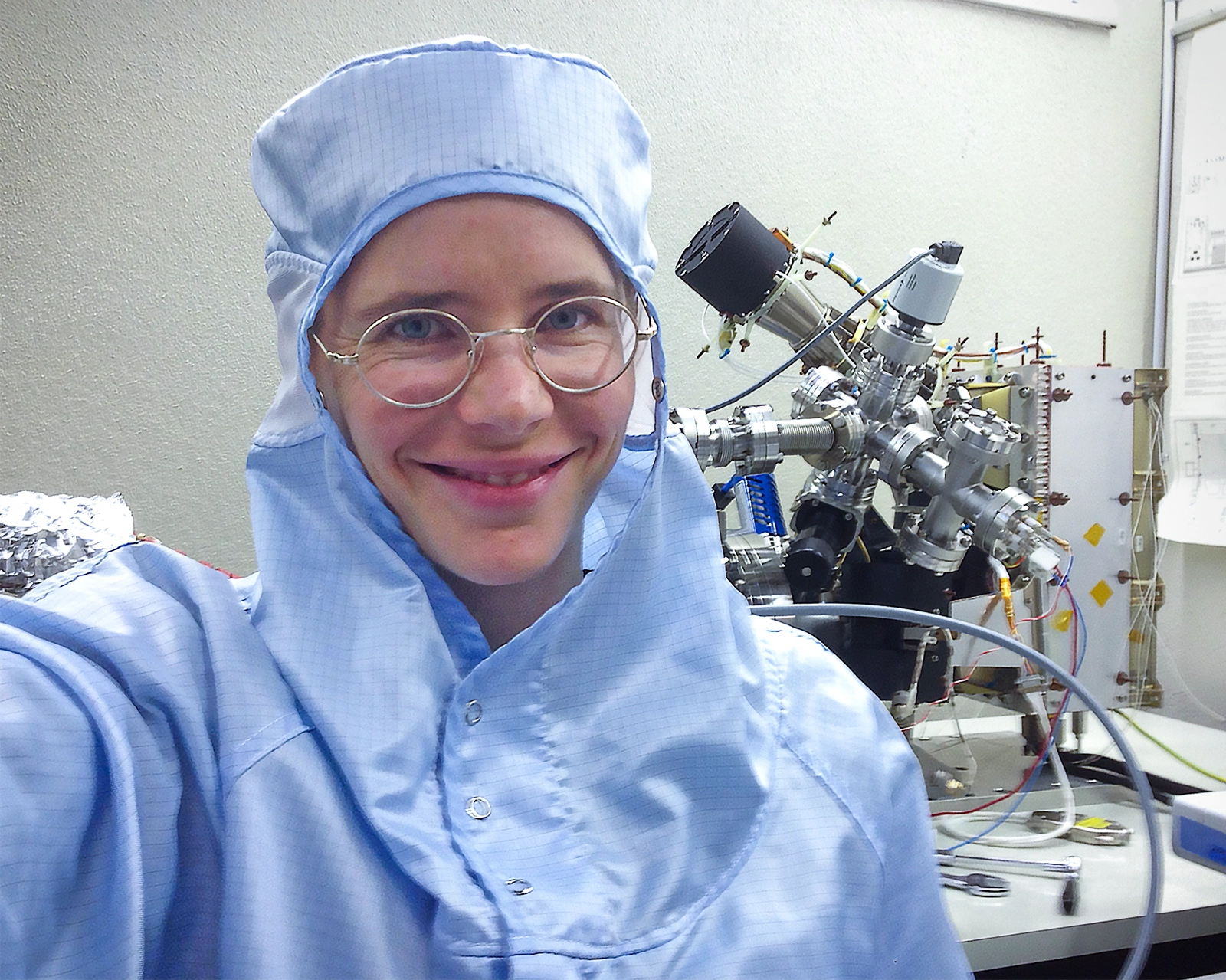
Nora Hänni, a chemist at the University of Bern, has been identifying and analyzing the complex organic molecules detected in comet 67P by the European Space Agency’s Rosetta probe.
Courtesy of Nora Hänni
Asteroids are less pristine than comets, having often endured heating and the effects of liquid water. But these effects can produce dramatic new organic complexity. For decades, scientists have known that meteorites called chondrites, which originate from asteroids, contain a staggering diversity of organic molecules. The Murchison meteorite, which fell in Australia in 1969, contains more than 96 different amino acids. Life uses just 20 or so. Osiris-Rex and Hayabusa2 have confirmed that the asteroids Bennu and Ryugu are as complex as those meteorites. And at least some of this complexity seems to have arisen before the asteroids themselves: A preliminary analysis of the Bennu sample suggests it retained organic material, including polycyclic aromatic hydrocarbons, from the protoplanetary disk.
The Chemistry of Life?
Organic molecules on the early Earth took a new, remarkable step up in complexity. They somehow organized themselves into something alive. Some hypotheses for the origins of life on Earth involve a starter kit of organic material from space. The “PAH world” hypothesis, for instance, posits a stage of the primordial soup that was dominated by polycyclic aromatic hydrocarbons. Out of this slurry the first genetic molecules emerged.
In general, understanding how complex organics form in space and end up on planets might give us a better idea of whether life has arisen on other worlds, too. If the raw materials of life on Earth formed in the interstellar medium, the stuff of life should be everywhere in the universe.
For now, such ideas remain largely untestable. But because life itself represents a new level of organic complexity, astrobiologists are hunting for complex organics as a possible biosignature, or sign of life, on other worlds in our solar system.
The European Space Agency’s Juice mission is already on its way to study Jupiter and three of its icy moons, and NASA’s Europa Clipper mission launched toward one of those moons, Europa, in October. Both will use onboard instruments to search the atmospheres for organic molecules, as will the future Dragonfly mission to Saturn’s moon, Titan.
Yet it’s tricky to determine whether a given organic molecule is a biosignature or not. If scientists were to find sufficiently complex organic molecular assemblages, that would be enough to convince at least some researchers that we’ve found life on another world. But as comets and asteroids reveal, the nonliving world is complex in its own right. Compounds thought to be biosignatures have been found on lifeless rocks, like the dimethyl sulfide Hänni’s team recently identified on 67P.
Hänni wants to use the abiotic complexity of comets to help rule out false-positive biosignatures and inform future searches for life. “It doesn’t matter if you want to look at exoplanet atmospheres or search for life in your own solar system; I think comets are really a great benchmark,” she said.
Life aside, these studies about the organic chemistry of space also open a window onto processes we might never observe directly.
Glein and his colleagues have used James Webb Space Telescope observations of methane in the outer solar system as evidence that some icy Kuiper Belt objects could have warm, wet interiors. The organic molecules on Europa could reveal the chemistry of its subsurface ocean. And Schmitt-Kopplin has used the organic assemblages of meteorites to study impact shocks and geochemical processes at the birth of the solar system. Life is just one act of the enormous cosmic drama recorded in organic molecules.
“Organic chemistry — it’s just kind of normal chemistry in the universe,” Schmitt-Kopplin said. “You always have a coevolution of the mineral world with the organic world.”
